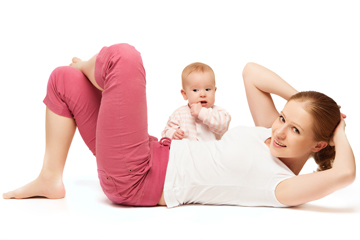 Pregnancy usually brings about pretty drastic changes to your body, your emotions, and your life. If you are a new mom, you may have gained a lot of weight during your pregnancy and might be wondering how to get back your pre-pregnancy body. The answer is simple: exercise. According to the American College of Obstetricians and Gynecologists, resuming exercise activities or incorporating new exercise routines after delivery is important in supporting lifelong healthy habits. However, you would need to get clearance from your doctor before you start any exercise program.
Pregnancy usually brings about pretty drastic changes to your body, your emotions, and your life. If you are a new mom, you may have gained a lot of weight during your pregnancy and might be wondering how to get back your pre-pregnancy body. The answer is simple: exercise. According to the American College of Obstetricians and Gynecologists, resuming exercise activities or incorporating new exercise routines after delivery is important in supporting lifelong healthy habits. However, you would need to get clearance from your doctor before you start any exercise program.
Maintaining fitness through exercise the following benefits for new moms:
- Helps get your body back in shape
- Strengthens and tones abdominal muscles.
- Boosts energy.
- May help prevent postpartum depression.
- Promotes better sleep.
- Relieves stress.
The 2008 guidelines of the U.S. Department of Health and Human Services recommend at least 150 minutes per week of moderate-intensity aerobic activity or brisk walking for healthy postpartum women.
There is a right way to start postpartum exercise. The first step in postpartum fitness is talk with your doctor to see when it’s safe for you to reincorporate exercise into your daily routine. A postpartum fitness professional can properly assess what exercise routine is appropriate for you as the postpartum journey is different for everyone. What’s most important is to take it easy at first. Since your body has undergone massive physical changes during pregnancy, birth, and postpartum, everything is likely to look and feel different during your initial workout after having a baby.
Experts recommend starting off with the following exercises:
- Pelvic floor strengthener (Kegels): Kegel exercises involve contracting and releasing the pelvic muscles and can be done almost immediately following childbirth (www.babycenter.com). They improve circulation to the pelvic area and help avoid problems such as incontinence. As the pelvic muscles tire easily, it’s best to do several contractions repeatedly throughout the day rather than in one session.
- Lie on your back with your knees bent and your feet flat on the floor.
- Tighten the pelvic floor muscles.
- Hold for a count of ten, then release. Repeat ten times. Try to work up to three or four sets about three times a day.
- Don’t tighten leg or abdominal muscles.
- Lying March: This workout is mainly for the abs.
- Lie face up with knees bent 90 degrees and aligned over hips, arms extended at sides and palms on the ground.
- Pull abs in, then slowly lower right foot, stopping just before it touches the ground.
- Raise right leg to starting position and repeat on left side to complete 1 rep.
- Twice a week, do 1 set of 12 to 15 reps, resting 30 to 60 seconds between sets.
- Head and shoulder raises: These help tone your abdominal muscles, though it can take weeks to recover your strength. Progress depends on how fit you were before getting pregnant.
- Lie on your back with your knees bent and your hands behind your head.
- Take a breath and, as you exhale, tighten your abdominal muscles, flatten the small of your back against the floor, and raise your head and shoulders off the floor. Keep your core muscles tight.
- Slowly lower and repeat the entire sequence eight to ten times.
- Pelvic tilt: This is another good exercise for strengthening the abdominal muscles.
- Lie on your back with your knees bent and your feet flat on the floor.
- Inhale and expand your abdomen.
- Exhale and lift your tailbone toward your navel, keeping your hips on the floor.
- At the top of the tilt, tighten your buttocks, then release.
- Repeat eight to ten times.
Along with these exercises, cardiovascular workouts such as brisk walking are also recommended. Start out with five minutes, two or three days per week, and work up to 20 minutes or more.
It’s very important to consult your doctor before you start any kind of exercise postpartum.